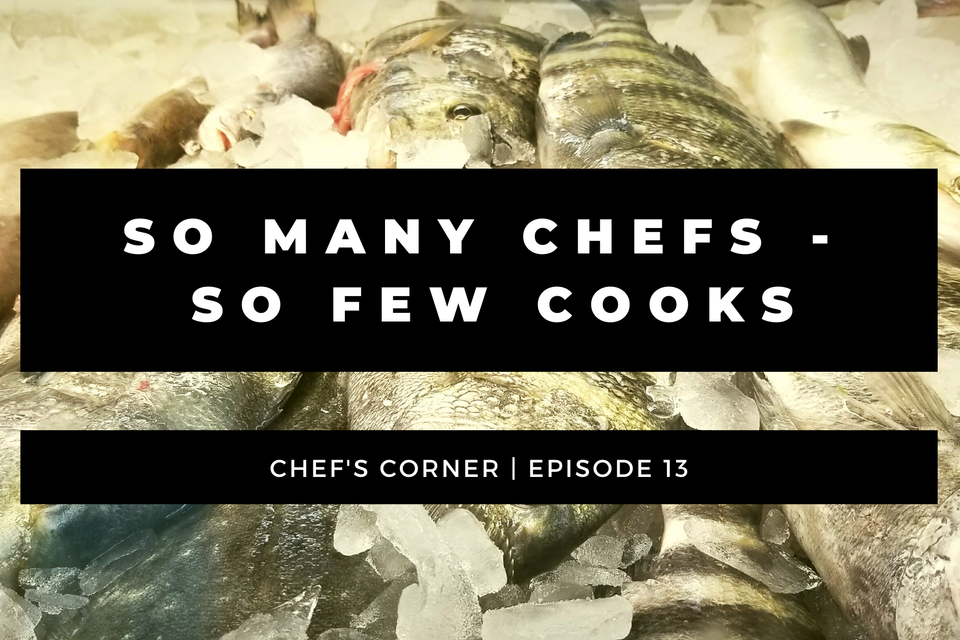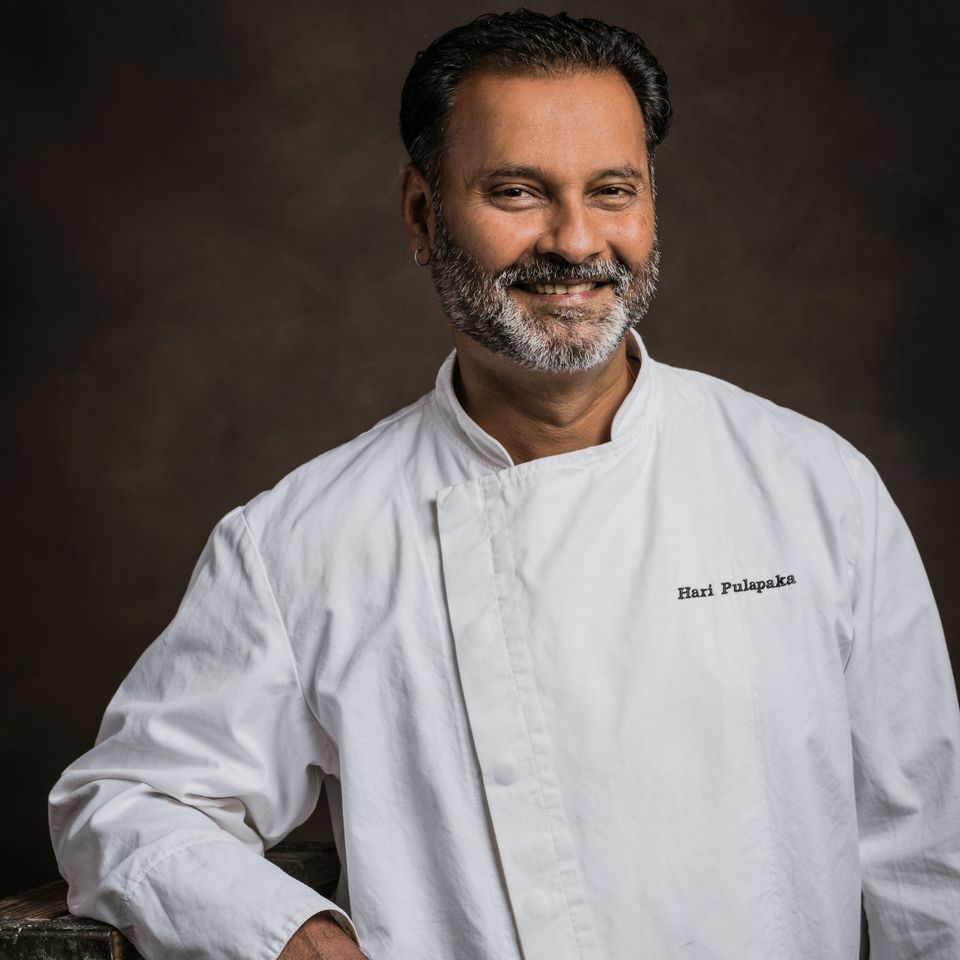So Many Chefs - So Few Cooks
By Hari Pulapaka, PhD, WCMC, CEC
January 27, 2021My shirt is soiled because I’ve been cooking. Streaks of chalk and dry-erase ink, coupled with a hoarse voice, point to lots of talking and, I hope, teaching. I don’t chef. I cook. I don’t profess. I teach. Professional titles aren’t verbs, just verbiage for hierarchy. Definitions matter.
Culinary programs across the United States, especially the for-profit ones, are doing a severe disservice to aspiring, wide-eyed entrants. Targeted marketing lures recruits with the promise of glamour and the title of becoming a “chef” almost immediately after graduation — just as they are being silently stuck with insurmountable and often unsecured loans that will typically take years, even decades, to pay off. I know. Cooking segments of a sexual-predator celebrity chef played on a loop at the Welcome Center of the Orlando Culinary Academy when I walked in as a nontraditional student experiencing a professional midlife crisis in 2004. I was already in credit-card debt management thanks to poor decisions and desperate financial need as a graduate student. Yet, I easily obtained an unsecured private loan from Sallie Mae at almost 13-percent annual interest that took me more than a dozen years to pay off.
Football and basketball athletes, especially at the elite and storied college athletic programs, lure youngsters with the promise of a star-studded and lucrative career in the professional leagues. Education is typically considered a necessary evil and, consequently, many of the student-athletes leave campus with a minimal appreciation of seeking knowledge beyond their passion for playing. To add insult to that injury, the vast majority of players will never competitively step foot in a professional arena in their lifetimes. It’s a game of numbers, talent, connections, and one’s ability to recognize and seize the opportunities that may come. There are only so many opportunities, and one’s prospects for reaching the next level are, generally speaking, slim.
On the distinction between a chef and a cook, one implies the other, but not necessarily actively. To be a chef, one has to be able to cook (a debatable reality) but, beyond that, the title comes with other responsibilities like managing and training employees, understanding and controlling inventory, balancing the books, and understanding what part of the operation is generating profit, and then maximizing it, given the constraints of the business model. The list goes on. I am a chef who also cooks (anybody hiring?). Post-restaurant, I am focused on setting the path of my food-centric company. What that means is that even while I may be engaged in the act of cooking, I am constantly cognizant of the other aspects of the business of my company. Most college-level culinary curricula cover cooking techniques as well as business and management basics. Often, the information is rooted in dated theories of what the day-to-day operations of a food-service operation look like. It is ironic and even tragic that a practical vocation like cooking is often presented in such an obsolete and impractical way. The number of high-profile articles lamenting the severe shortage of passionate and talented individuals who are capable and committed to putting in what it takes to be at least a good cook, let alone being a chef, is growing by the day. Often, students lack even the skills it takes to be a proficient cook. Their chances of being a chef are even slimmer.
“My child, husband, or wife is a really good chef” is a phrase I hear frequently. In this context, let’s stop using that “C” word and use the other “C” word. Calling everyone who cooks a chef is, at the very least, insulting to the profession and promulgates unrealistic expectations. When I introduce myself to guests during a dinner service, I usually say “I’m the cook.” Often, guests are not sure how to react to that introduction. If they don’t know me, they naturally assume I am not part of the ownership or management. Sometimes, a certain condescending pattern follows. My self-introduction is not an attempt to be falsely modest. But, in fact, I am proudly sharing with the guest that I am engaged in the act of cooking. That is what I do. I am not chefing, but rather, I am cooking. That is what directly puts food on the plate. I also joke somewhat seriously that “Cooks cook, while chefs have to pay bills.”
“We should emphasize the craft of cooking over the glamour of chefing.”
Shows like MasterChef Junior and MasterChef are perpetuating the notion that somehow cook and chef are, for all practical purposes, interchangeable, when, in fact, that couldn’t be further from the truth. One (cook) highlights the practice, while the other (chef) indicates a stature and position beyond the craft. Definitions matter. There is nothing real about most of these reality shows. Their popularity is further waning the competency in the applicant pools of cooks who may someday become chefs. “Chef” is an earned title like “professor,” “judge” or even “doctor.” I think I’ve earned that title, but what I do is cook. I don’t chef. I would rather that we emphasize the craft of cooking over the glamour of chefing.
Local Ingredient of the Week
SHEEPSHEAD
This species of fish is plentiful in our waters, and while it may not be rated by Seafood Watch, sheepshead gets a bad rap in fussy restaurants — I served it every chance I got. In the Porgy family, they are a bit of a bear to clean and fabricate, but let the fine folks at King’s Seafood in Port Orange handle the breaking down of this convict-patterned species. I think it’s time national seafood watch rating agencies like Monterey Bay Aquarium’s Seafood Watch (which I support) gave sheepshead a good look and listed it appropriately.
Spice of the Week
MUSTARD SEEDS
Mustard seeds may be derived from a wide variety of mustard plants. Their color ranges from white to black, with many shades in between. Mustard seeds have become ubiquitous in pickles and as a condiment, but in India, we cook with them. Growing up, the aroma of popping mustard seeds, curry leaves, and asafetida in hot oil meant that the meal was almost ready because “tadka” was the final step in the preparation of the daily “bhaji,” “charu” or “pulsu.” Even though we were just in India, I miss everything about her.
Recipe of the Week
‘Macher Jhol’ (Bengali Fish Curry)
The first time I ate authentic Bengali food was at the restaurant “Oh! Calcutta” at Nehru Place in New Delhi. It is also where I first ate properly cooked banana flower. Mustard fish is a staple of Bengali cuisine and, of course, every family interprets it in their own way. Anyone who thinks they’ve had typical Indian food, will concede after trying this dish that Indian cuisine is not just about flavors from the North or the South. India also has a West and, as in this case, an East.Servings: 4
INGREDIENTS4 eight-ounce filets of skinless and boneless sheepshead or golden tilefish
3 medium onions, minced
1 tablespoon fresh ginger, minced
1 tablespoon fresh garlic, minced
8-10 curry leaves
2 tablespoons mustard seeds
1/2 cup fresh grated unsweetened coconut
2 green chilies, diced (with seeds)
1 tablespoon cumin seeds
1 tablespoon coriander seeds
2 teaspoons ground turmeric
1/2 cup mustard oil
1 cup coconut milk
1 cup crushed tomatoes
cilantro, fresh, as needed
vegetable or fish stock, as needed
kosher salt - to taste
freshly ground black pepper - to taste
METHOD1) Dry roast (on low heat) the coconut, mustard seeds, curry leaves, coriander, cumin, and green chilies in a pan until the coconut starts to brown. This will take about 15 minutes. Add a bit of water, and blend in a processor to a paste.
2) Cook the blended paste in mustard oil on medium heat for 5 minutes, while stirring.
3) Add the onions, curry leaves, turmeric, ginger, and garlic. Cook for 5 minutes.
4) Add the tomatoes, stock, and coconut milk. Season with salt and pepper, and simmer on a low heat for 15-20 minutes. Blend smooth or leave it chunky depending on preference.
5) Season the fish lightly and pan roast it in mustard oil until it is half done, and add to a pan with enough curry sauce to barely cover the fish. Simmer on low to finish the curry.
6) Garnish with fresh cilantro. Serve with steamed basmati or jasmine rice.Why is the Chef in a Corner?
After spending well over a decade in my little restaurant kitchen fully immersed in getting sh!t done, I’m ready to bust out of my corner.
Each week, I will pass judgment on a segment of food news that may or may not be interesting, shed light on a seasonal (for us) food ingredient or two, and dream up some minutiae about a spice I love and think you should, too.
In true elitist fashion, I will share a recipe with you, because academia is in my blood and academics think everything they do or say is supremely relevant and important.
I am here to champion the worth of food while fighting for flavor and the people who help provide food on our tables. What percentage of Americans eat at the dining table these days? It has been on the decline for the past decade because by many measures, “the kitchen ate the dining room.”
Photo Credit: Hari Pulapaka
About Chef Hari



